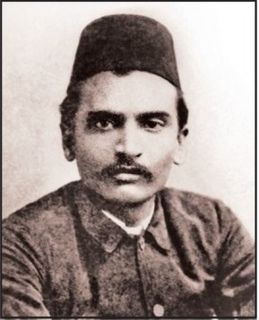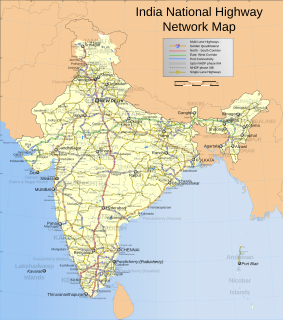Related Research Articles

Swami Vivekananda, born Narendranath Datta, was an Indian Hindu monk and philosopher. He was a chief disciple of the 19th-century Indian mystic Ramakrishna. Influenced by Western esotericism, he was a key figure in the introduction of the Indian darsanas of Vedanta and Yoga to the Western world, and is credited with raising interfaith awareness, bringing Hinduism to the status of a major world religion during the late 19th century. He was a major force in the contemporary Hindu reform movements in India, and contributed to the concept of nationalism in colonial India. Vivekananda founded the Ramakrishna Math and the Ramakrishna Mission. He is perhaps best known for his speech which began with the words "Sisters and brothers of America ...," in which he introduced Hinduism at the Parliament of the World's Religions in Chicago in 1893.
The following outline is provided as an overview of and topical guide to Hinduism:

The Kambojas were a tribe of Iron Age India, frequently mentioned in Sanskrit and Pali literature. The tribe coalesced to become one of the shodhasha (sixteen) Mahajanapadas of ancient India mentioned in the Anguttara Nikaya. Duryodhana's wife Bhanumati was daughter of Magadha King Chitranga and Queen Chandramundra.The Kambhoja king Sudakshina was defeated by Karna.
Goswami is an Indian title and surname. The Sanskrit compound Goswami may mean "lord of the senses" or lord of the Vedas. It is also pronounced as Gosains, Gossain, Gosain, Gosavi and Gossains.

The history of science and technology in the Indian subcontinent begins with prehistoric human activity in the Indus Valley Civilization to early states and empires. Following independence, science and technology in the Republic of India has included automobile engineering, information technology, communications as well as space, polar, and nuclear sciences.

Swaraj Prakash Gupta was a prominent Indian archaeologist, art historian authority, Chairman of Indian Archaeological Society, founder of the Indian History and Culture Society, and Director of the Allahabad Museum. He was most noted for several excavations Indus Valley Civilisation sites and for his support of the existence of a destroyed Ram Mandir underneath the Babri Masjid in Ayodhya.
Govind Chandra Pande was a well-known Indian historian of the Vedic and the Buddhist periods. He served as professor of ancient history and vice-chancellor at Jaipur and Allahabad universities. He was also the chairman of the Indian Institute of Advanced Study, Simla for several years, the Chairman of Allahabad Museum Society and the Chairman of Central Tibetan Society, Sarnath Varanasi.

Ranjitram Vavabhai Mehta was a Gujarati language writer from British India.

Tanjore Ramachandra Anantharaman was one of India's pre-eminent metallurgists and materials scientists.
The Centre for Studies in Civilizations (CSC), founded 12 October 1995, is a non-governmental organization (NGO) based in India. According to their website, the center "aims at conducting, promoting and facilitating studies and research in the broad areas of history, philosophy, culture, science and technology", and "undertakes and promotes research in relation to the past, the present and the future courses, contents, and trends of civilizations in general, and Indian civilization in particular." While its office is located in Delhi, the ten members of its governing body live throughout India. In addition to its literary work, the Center organizes symposia and talks by eminent scholars, politicians, writers and spokespeople.
Munshiram Manoharlal Publishers Pvt. Ltd. (MRML) is a leading publishing house located in New Delhi, India. Established in 1952 by Manohar Lal Jain, it is one of the oldest publishing houses in India.

This is a bibliography of notable works about India.

Swami Vivekananda (1863–1902) was an Indian Hindu monk and a key figure in the introduction of Indian philosophies of Vedanta and Yoga to the western world. He was one of the most influential philosophers and social reformers in his contemporary India and the most successful and influential missionaries of Vedanta to the Western world. Indian Nobel laureate poet Rabindranath Tagore's suggested to study the works of Vivekananda to understand India. He also told, in Vivekananda there was nothing negative, but everything positive.
Kapil Kapoor is an Indian scholar of linguistics and literature and an authority on Indian intellectual traditions. He is former Pro-Vice-Chancellor of Jawaharlal Nehru University (JNU) and served as professor at the Centre for Linguistics and English, and at the Centre for Sanskrit Studies there before retiring in 2005. He is Editor-in-Chief of the 11-Volume Encyclopedia of Hinduism published by Rupa & Co. in 2012.
Sushil Kumar De was a Bengali writer from the early decades of the 20th century. Trained as a lawyer, with degrees in English and Sanskrit Poetics, he wrote extensively on Sanskrit Literature, Philosophy, Poetics, History of Bengali Literature, besides editing critical editions for a large number of Sanskrit and Bengali texts from manuscripts.
Dawn was an English-language magazine launched in 1897 by Bengali Indian educationalist Satish Chandra Mukherjee. The magazine arose at a time of growing nationalism in India and particularly Bengal in the last part of the 19th century, and propagated Mukherjee's views on national education in the context of the emerging nationalist movement in India, and promoted Mukherjee's message of recalling India's cultural and philosophical heritage. The magazine achieved widespread circulation by early 1900s, and particularly criticised the movement towards colonial domination of institutes of higher education that became ratified in the Universities bill, 1904. The magazine was considered a journal of high standard and taste amongst Bengali intelligentsia. The magazine went on to lend its name to a society that arose from a conglomeration of Bengali intellectuals and eminent scientists who contributed to the magazine, and articles appeared on various subjects including Science, technology and similar subjects focussed on the needs in the society. The magazine was published monthly, in English. Each number of the journal was divided into three parts. Lal Mohan Mullick served as the publisher, Mukherjee contributed as editor in a number of Science-themed articles, and in a dedicated column entitled Indiana, he wrote on many aspects of Indian civilisation.
Ravinder Goswami is an Indian endocrinologist and professor at the department of endocrinology and metabolism at the All India Institute of Medical Sciences, Delhi. Known for his research on vitamin D deficiency, Goswami is an elected fellow of National Academy of Sciences, India and Indian Academy of Sciences. The Council of Scientific and Industrial Research, the apex agency of the Government of India for scientific research, awarded him the Shanti Swarup Bhatnagar Prize for Science and Technology, one of the highest Indian science awards for his contributions to Medical Sciences in 2008.

Dr. Satyanarayana Dasa is an Indian Gaudiya Vaisnava scholar and practitioner. Dasa is a polymath, holding a Ph.D. in Sanskrit from Agra University, a degree in Indian law from Agra University, a Bachelors of Technology in Mechanical engineering from the Indian Institute of Technology and a Masters of Technology in Industrial Engineering from the Indian Institute of Technology. Currently based in India at the Jiva Institute, which he founded, Dasa has published numerous books and original papers in the field of Gaudiya Vaisnavism including translations and commentaries on the Sat Sandarbhas. His honors include an award from the President of India in 2012. Dasa has been called a leading living practitioner-scholar of Jīva Gosvāmin.

Hinduism in Vietnam is mainly observed by the ethnic Cham people. Balamon Cham is one of two surviving non-Indic indigenous Hindu peoples. Around 60,000 Hindus live in Vietnam today.